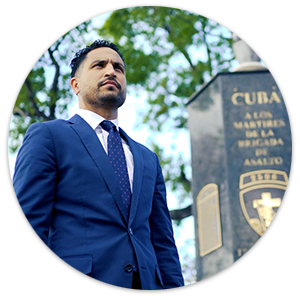When courts handle excessive force cases, one of the key questions they examine is whether the officer involved acted in a way that would be considered reasonable under the circumstances. This is where the “reasonable officer” standard comes into play. It is not enough for a court to simply decide if the officer’s actions seem fair or unfair. Instead, the court must carefully evaluate the situation from the point of view of a typical law enforcement officer in the same situation. Understanding how courts apply this standard is crucial in determining whether excessive force was used in any given case. At, The Guzman Firm, PLLC, we are here to guide you through the legal process and help you navigate the complexities of your case.
Richard Guzman’s expertise focuses on one primary objective: to offer tactical legal analysis, guidance, and result-driven solutions. The Guzman Firm is dedicated to providing you with the knowledgeable and competent counsel you deserve.
Attorney Richard Guzman
The Origin of the “Reasonable Officer” Standard
The “reasonable officer” standard comes from a Supreme Court decision in a case called Graham v. Connor, which was decided in 1989. In this case, the court ruled that the actions of law enforcement officers should be judged based on what a reasonable officer would have done at the time of the incident, rather than using hindsight. This ruling emphasized that law enforcement officers often have to make split-second decisions in tense situations, and their actions should be viewed through that lens. Courts must assess whether the force used was appropriate, given the facts known to the officer at the time, without focusing on what is discovered afterward.
Looking at the Totality of the Circumstances
When courts examine whether an officer acted reasonably, they look at the entire situation, which is called the “totality of the circumstances.” This means that courts do not just focus on one part of the event but instead consider everything that happened leading up to and during the encounter. Some factors that courts often consider include the severity of the crime the suspect is accused of, whether the suspect posed an immediate threat to the officer or others, and whether the suspect was actively resisting arrest or trying to flee.
Each of these factors plays a role in shaping how the court views the officer’s decision to use force. For example, if the suspect was unarmed and not acting aggressively, the court may find that the use of force was not justified. On the other hand, if the suspect was armed or acting in a dangerous manner, the court may be more likely to conclude that the officer’s use of force was reasonable under the circumstances.
Judging the Officer’s Decision-Making in the Moment
A key part of applying the “reasonable officer” standard is understanding that officers often have to make quick decisions in situations that are stressful or rapidly changing. Courts recognize that officers do not have the luxury of carefully weighing all their options before acting. Instead, they often need to make snap judgments based on incomplete or unclear information. For this reason, the court gives officers some leeway when evaluating their actions. This means that even if the officer’s decision to use force turned out to be unnecessary in hindsight, the court might still find the officer’s actions reasonable if they were justified at the time based on what the officer knew.
At the same time, this does not mean that officers have a blank check to use force whenever they feel like it. Courts still carefully evaluate whether the officer’s actions were appropriate under the circumstances. If the court determines that an officer used force when it was not necessary, or that the force used was excessive compared to the threat posed by the suspect, the officer’s actions may be found to have violated the suspect’s constitutional rights.
“Richard is deeply invested in his community and is a professional of purpose and integrity. As our legal counsel, his strategic approach, proactive communication, and commitment to our organization’s needs and goals have helped us navigate challenges as well as build important partnerships.” “I go to Richard Guzman because of trust. He was recommended by my dear sister that had the pleasure of working with Mr. Guzman. By having a direct recommendation, I did not doubt that he could ease my worries and that I would be backed by a knowledgeable, trustworthy professional.”![]()
Dejha C.
![]()
Piero S.
Objective vs. Subjective Intent
An important aspect of the “reasonable officer” standard is that it is an objective test. This means that the court does not consider the officer’s personal intentions or motivations when evaluating the use of force. Instead, the focus is on whether a reasonable officer in the same situation would have acted similarly. Even if the officer had good intentions or believed they were acting in the best interest of the public, the court will only consider whether the actions were justified based on the facts of the situation.
On the other hand, the officer’s subjective state of mind, such as whether they were angry or frightened, does not play a role in the court’s evaluation of the case. The court is only concerned with what the officer did and whether it was reasonable in light of what a typical officer might have done in the same circumstances. This objective approach ensures that the standard is applied fairly and consistently, without giving too much weight to the individual officer’s personal feelings or beliefs.
Excessive Force and Constitutional Rights
When courts assess whether excessive force was used, they are also considering whether the officer’s actions violated the individual’s Fourth Amendment rights. The Fourth Amendment protects people from unreasonable searches and seizures, which includes protection from excessive force by law enforcement. If the court finds that the force used was unreasonable under the “reasonable officer” standard, it can conclude that the officer violated the individual’s Fourth Amendment rights.
In making this determination, courts often weigh the government’s interest in using force to maintain public safety against the individual’s right to be free from harm. If the court finds that the government’s interest in using force was low, but the level of force used was high, the court may find that the officer’s actions were unconstitutional. This balancing of interests helps ensure that officers are held accountable when they overstep their bounds, while also allowing them to use force when it is necessary to protect themselves or others.
Examples of How Courts Apply the Standard
One of the challenges in excessive force cases is that each situation is unique. Courts must examine the specific details of each case to determine whether the officer acted reasonably. For example, in a case where an officer uses a taser on a suspect who is actively resisting arrest, the court may determine that the use of force was justified because the suspect’s actions posed a threat to the officer’s safety. However, in another case where an officer uses a taser on a suspect who is not resisting, the court may conclude that the use of force was excessive and unreasonable.
Similarly, the amount of force used plays a significant role in how courts assess these cases. For example, if an officer uses deadly force, such as firing a gun, the court will closely examine whether the officer’s decision to use such force was truly necessary given the threat posed by the suspect. If the court finds that the suspect did not pose an immediate threat to the officer or others, the use of deadly force may be deemed unreasonable.
The Role of Police Training and Policies
Another factor courts may consider is the officer’s training and the department’s policies on the use of force. Many law enforcement agencies have specific guidelines on when and how officers are allowed to use force. While these policies do not determine the outcome of excessive force cases, they can provide valuable context for the court’s decision. If an officer violated their department’s use-of-force policy, this might be an indication that the officer’s actions were unreasonable. However, even if the officer followed their training and department policies, the court may still find that the force used was excessive if it violated the individual’s constitutional rights.
It is important to note that police training and department policies can vary widely from one jurisdiction to another. What may be considered reasonable in one city or state may not be seen the same way in another. This is why courts rely on the “reasonable officer” standard as a way to maintain consistency in how these cases are evaluated across different jurisdictions.
The Importance of Court Decisions in Shaping Law Enforcement Practices
Court decisions in excessive force cases play an important role in shaping how law enforcement agencies approach the use of force. When courts rule that certain actions are unreasonable, it can lead to changes in police training, policies, and practices. This helps ensure that officers are better equipped to handle difficult situations in a way that protects both their safety and the rights of individuals they encounter.
In some cases, court rulings may also result in civil lawsuits against the officer or the police department. If the court finds that the officer violated the individual’s constitutional rights, the individual may be awarded damages for the harm they suffered. This serves as a reminder that law enforcement officers must act within the bounds of the law and that there are consequences when those boundaries are crossed.
Excessive force cases can be complex, but the “reasonable officer” standard provides a framework for courts to assess whether an officer’s actions were justified. By examining the totality of the circumstances and applying an objective test, courts are able to fairly evaluate the actions of law enforcement officers. This standard helps balance the need for officers to protect public safety with the individual’s right to be free from harm.
If you or someone you know has been involved in an excessive force case, The Guzman Firm, PLLC is here to provide the guidance and support you need. We are dedicated to protecting your rights and helping you seek justice. Reach out to us today to discuss your case and learn how we can assist you in navigating this complex area of law.
